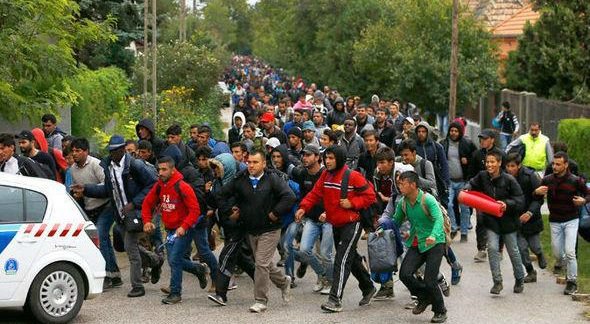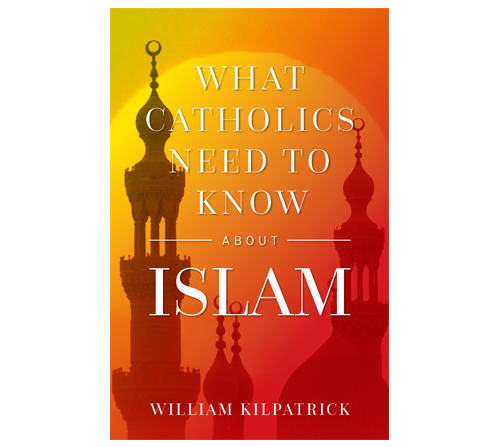As part of a two-year campaign to promote the acceptance of migrants, the USCCB is issuing a brochure titled “Our Faith Teaches: Welcoming the Refugee and Migrant.”
Among other things, the brochure reminds us that Jesus was a migrant and refugee. The implication is that in welcoming the migrant we are welcoming Jesus. But it’s useful to remember that Muhammad also was a migrant and refugee. In 622 AD, he, along with about one hundred followers, migrated from Mecca to Medina. Since he claimed that he was being persecuted by the Meccans, Muhammad also qualified as a refugee.
The citizens of Medina extended a warm welcome to the Muslims, but before long they were sorry they had. Muhammad took over the city and slaughtered many of its inhabitants. He also used it as his base for raids on caravans and other tribes. The resulting booty attracted many recruits to the new religion, and the nascent religion grew in strength and numbers.
In fact, the migration to Medina was really the breakout point for Islam. This explains why the Muslim calendar begins with the year of the migration, not with the birth of Muhammad or with his first revelation.
Pope Francis and others in the hierarchy tell us that the face of the refugee is the face of Christ. Of course, that is true in a sense. But, metaphorically speaking, we may also be justified at times in seeing the face of Muhammad in the face of Muslim refugees.
However decent individual Muslim migrants may be, they carry with then the seeds of the faith Muhammad founded. In order to keep that faith alive, Muslim leaders “encourage” the faithful not to assimilate. In fact, President Erdogan of Turkey has called assimilation a “crime against humanity.” What he has particularly in mind is the large and growing immigrant Turkish population in Germany which he sees as the vanguard of the eventual Islamization of that country.
Typically, Muslim immigrants and refugees do not assimilate into their host culture; they form parallel societies, where the customs and laws of Islam set the tone. That means that in these ghettos there is little if any freedom of religion, equality of the sexes, or freedom of expression. On the other hand, there is a great deal of anti-Semitic and anti-Christian sentiment.
And then there is the problem of violence. As a result of recent Muslim migration into Europe, there has been an enormous spike in crime. To take one small example, consider Denmark, a country that one does not usually associate with crime or violence. As a spokesman for Denmark’s majority government party recently said, “We have not had such warnings from the police since the Second World War.”
Warnings about what? How about:
Thousands of incidents involving loosened wheel bolts on cars, large rocks or cinder blocks thrown from highway overpasses, and thin steel wires strung across bicycle paths meant to decapitate unsuspecting cyclists, is spreading a growing sense of horror among the Danes.
In addition, “gangs of migrants and refugees of Arab or North African descent are now shooting innocent people at random in the capital city of Copenhagen.”
The suffering victims of these crimes also qualify as “the face of Jesus,” but we don’t hear much about them, and we seldom see pictures of them. On the other hand, pictures of refugees are everywhere. The website for the USCCB’s “Week of prayer and action for migrants and refugees” contains many photos. Curiously, almost all the photos are of Muslims, and more curiously still—considering that about seventy percent of refugees entering Europe are grown males—they are mostly of women and children.
The toolkit that comes with the “prayer and action” campaign contains instructions to ask God to “continue to call me beyond my comfort and into encounter.” Photos of vulnerable women and children are meant to reassure Catholics that they won’t have to go too far outside their comfort zone. But since an encounter with a cinder block thrown from a highway bridge is not within most people’s comfort zone, no information is provided about the downside of Muslim migration.
What is missing from the bishops’ campaign materials is any larger context in which to place the issue of Muslim migration. There is no hint that in welcoming the migrant, you may also be welcoming the cruelties of sharia law, the oppression of women, the end of free speech and freedom of religion, and the persecution of Jews and Christians. Catholics who are contemplating the issue should also know something about the fact that Muslims have historically used migration as a form of conquest.
Of course, one doesn’t expect that in a matter of faith and morals, the Church should have to carefully present both sides of the argument and then let the individual decide. But that’s the point. Immigration policy is not a matter of faith and morals. There is no doubt about how Catholics should regard abortion, but there is considerable doubt about how to regard mass migrations—especially when they come from cultures that are hostile to Christianity.
In fact, the Catechism is far more nuanced on the issue of immigration than is the USCCB. It says:
Political authorities, for the sake of the common good for which they are responsible, may make the exercise of the right to immigrate subject to various juridical conditions, especially with regard to the immigrants’ duties toward their country of adoption.
The Catechism then goes on to say: “Immigrants are obliged to respect with gratitude the material and spiritual heritage of the country that receives them, to obey its laws and to assist in carrying civic burdens (par 2241).
But this is precisely what a large number of Muslim migrants—especially in Europe—are failing to do. Many of them have little use for European laws, let alone its spiritual heritage. Their attitude is captured in a poster sometimes seen at Muslim demonstrations: “Europe is the cancer, Islam is the answer.”
The Catechism also speaks of the common good. But what makes for the common good is not always easy to decide. Muslims in European refugee centers may be more secure than they were previously, but Christian refugees who share the same centers may be at greater risk of assault and murder. An 18-year old Syrian refugee suspected of planting an explosive device on a London train is believed to be a foster child taken in by an elderly couple who had been honored by the Queen for their charitable work over the years. As it turned out, their act of kindness provided a safe space for the youth to plan his attack. The couple shouldn’t be held responsible for the thirty people injured in the blast, but the incident does demonstrate that charity to one sometimes results in harm to others. “Love your neighbor” applies not only to the “other,” it also includes your literal neighbor next door. In this case, neighbors of the generous couple had to be evacuated for fear that explosives had been hidden in their house.
But little of the nuance in the Catechism or the complexities of the situation on the ground in Europe is reflected in the bishops’ campaign for refugees. Rather, the campaign materials give the impression that the migrant matter is already settled: good Catholics must welcome migrants and refugees. To do otherwise is selfish and sinful.
In his many appeals to Europeans to take in more migrants, Pope Francis gives the same impression. In his latest statement the Pope adopts a scolding tone toward Europeans for their “defensiveness and rejection”. “I won’t hide my concern in the face of the signs of intolerance, discrimination, and xenophobia” which, the pope said, are “often fueled by reticence and fear of the other, the one who is different, the foreigner.”
The language is emotionally charged: words such as “defensiveness,” “intolerance,” and “xenophobia” suggest that European opposition to Muslim migration has no other basis than small-minded bigotry. In short, Francis fails to do justice to their real concerns. Europeans are not worried about sharing their countries with the “other.” It’s something they’ve been doing for a long time. What they’re worried about are the “others” who have recently been raping, rampaging, and setting off bombs. In his recent talk, the pope speaks dismissively about “temptations to exclusiveness and cultural entrenchment” as though these were the only factors that could explain the recent resistance to migration. But how about temptations to survival? Concerns that one’s family could be blown to bits in a train station or concert hall, or run down by a jihadist in a rented truck? You can call this “exclusiveness,” but most people would call it common sense.
Robert Spencer puts it this way:
The Pope, by portraying opposition to the Muslim migrant influx as a moral issue and trying to shame people out of that opposition, is helping to expose the non-Muslim people of Europe, and their children and children’s children, to a future full of misery and bloodshed. Is that really what a Christian leader should be doing?
This, too, is emotionally charged language, but it has the merit of being backed up by statistics—not just statistics about the numerous jihad terror attacks and the more numerous foiled plots, but data indicating an exponential increase in crime and violence in every European country that has admitted large numbers of Muslim migrants and refugees. Against the almost certain future envisioned by Spencer, Francis can only offer vague possibilities: the “possibility of growth and enrichment,” the possibility that “the Holy Spirit will help us to keep an attitude of trusting openness that will allow us to overcome every barrier and scale every wall,” and (from a previous talk) the possibility that cultural encounters could be a way of “transforming the whole of humanity.”
In light of what is actually happening as a result of mass migrations, this sounds more like wishful thinking than the theological virtue of hope. Political and moral decisions need to be based on realities. It’s crucial to understand the actual situation you face. What is the reality of mass Muslim migration? Is it simply a matter of needy people seeking safety and a better life? Or is it, as some say, a consciously planned cultural invasion? Or is it something in between? If it’s an invasion from a culture that intends to subjugate your own, then those who call for more migration are arguably enabling the spread of an evil force.
Whatever the case, it is becoming increasingly difficult to argue that mass Muslim migration will enhance the common good, let alone “transform the whole of humanity.” The tragic facts about daily life in Europe today don’t support such a starry-eyed view.
Ironically, Pope Francis himself has conceded the point about getting your facts straight. In Evangelii Gaudium, he observes that “ideas disconnected from realities give rise to ineffectual forms of idealism” (232). Unfortunately, he then proceeds to paint a totally unrealistic picture of Islam and the Koran. In paragraph 253 he contends that “authentic Islam and the proper reading of the Koran are opposed to every form of violence.”
That certainly qualifies as an idea “disconnected from realities,” and in the years since, Francis has shown no sign that he has become more realistic about either Islam or Muslim migration.
In 622 AD, Muhammad and his followers migrated to Medina. He quickly colonized that city, and used it as a launching pad for his conquest of Arabia. Within a century of his death, his followers had conquered half the known world. In our own time, Muslims have undertaken a much larger migration. The base they are establishing in Europe may conceivably allow them to conquer the rest of the world for Allah.
This is not a time for wishful thinking.
This article originally appeared in the October 5, 2017 edition of Catholic World Report


